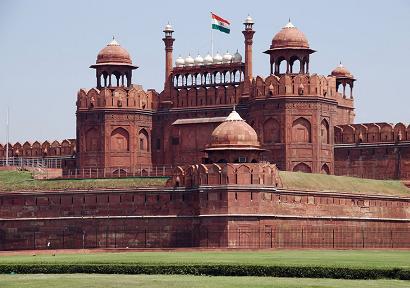|
Red Fort or
Lal Qila is most wonderful and oldest monument of Delhi. The Red
Fort was founded in the year 1648 by Emperor Shah Jahan. The emperor Shah Jahan
built this fort on the banks of Jamuna in Shahjahanabad, the city
founded by him which is now known as Old Delhi.
This fort
is one of the most amazing pieces of Mughal structural design. The Red
Fort is among the most wonderful palaces of the world. Shah Jahan was one
of the greatest rulers of the Mughal Dynasty in India. In 1638 when
the emperor moved the capital of India from Agra to Delhi, a new royal
palace was constructed which was known as the Red Fort or Lal Qila.
The
construction of the Red Fort begins in the year 1638 by Emperor Shah
Jahan and it was finished in the year 1648. For about more than 200
years, Red Fort served as the hub of the Mughal Empire. |

Red Fort |
|
The Red
fort is very dominant fort with huge fortifications. The Lal Qila
rises above a 9 m wide dry deep moat, initially fed by Yamuna River.
Yamuna
River has now shifted itself more than 1 km to the East. Red Fort is
famous due to its huge red sandstone walls and the magnificient
structure.
Red Fort is
constructed in an octagon shape measuring 900 m by 550 m. The fort has
some of the buildings of the Mughal government which are Diwan-i-Khas
(Hall of private audiences), Diwan-i-am (Hall of public audience),
domed and palaces of marble, luxurious private apartments, a mosque
and richly designed gardens.
Even today, the fort remains an imposing evidence to majesty of
Mughals, in spite of being attacked by the Persian Emperor Nadir Shah
in 1739 and by the British soldiers in 1857 during the war of
independence. Visitors can enter the Red Fort through magnificent
Lahori Gate and Delhi Gates. Lahori Gate is the main entrance of the
fort which leads to Chatta Chowk which is a shopping area.
The Fort exhibits a high level of decoration, and the Kohinoor diamond
was part of the furnishings. Various artworks are seen in the fort
like Indian, Persian and European art.
Major structures with the Fort are: Diwan-i-Aam, Delhi Gate, Diwan-i-Khas,
Chhatta Chowk, Hayat Bakhsh Bagh, Rang Mahal, Khas Mahal, Lahori Gate,
Water Gate, Naubat Khana, Nahr-i-Behisht, Mumtaz Mahal, Hammam, Moti
Masjid, Hira Mahal, Shahi Burj and Princes quarter. |
|
Chatta
Chowk - The main entrance Gate of the fort leads to the Chatta
Chowk. it is a shopping centre during the Mughal period for the ladies
of the court. In Chatta Chowk items like jewellery, silk and other
household items were sold.
This bazaar has a large display of collection of jewellery, antiques,
miniature paintings, ivory, silk, household items and carpets.
Naubat Khana - Naubat Khana is situated beyond the Chatta
Chowk. It is the heart of the fort. The musicians usually play for the
emperor from the Naubat Khana and the arrival of princes and royals
was indicated from this place.
Public Audiences or Diwan-i-Am - The Fort also Hall of Public
Audiences or Diwan-i-Am where the Emperor would sit and listen to
complaints of people. It is also used for the functions of the state.
Mumtaz Mahal - Mumtaz Mahal has the Archaeological Museum of
Red Fort.
Diwan-i-Khas - It is built in White Marble decorated with
precious stones, it is the hall of the private audience where private
meetings are held by the Emperor. On the ceiling above it are written
the well-known verses of Amir Khusro in gold letters "If there is a
heaven on earth, it is this, it is this, it is this." Today, the
Diwan-i-Khas is only a pale shadow of its original magnificence, yet
the verses of Amir Khusro reminds us of its former wonder.
The other
attractions within this monument are the Royal Baths or hammams, the
Shahi Burj, which used to be Shah Jahan's private working area and the
Moti Masjid or the Pearl Mosque, built by Aurangzeb for his personal
use.
Rang
Mahal - Rang Mahal or "Palace of Colours" is the place only
for the wives and mistresses of the Emperor. This palace holds an
amazing Lotus shaped fountain which is built of a single piece of
marble. This place is amazingly decorated with beautiful paintings,
elaborate mirrors and the ceiling of the palace is adorned with gold
and silver.
|